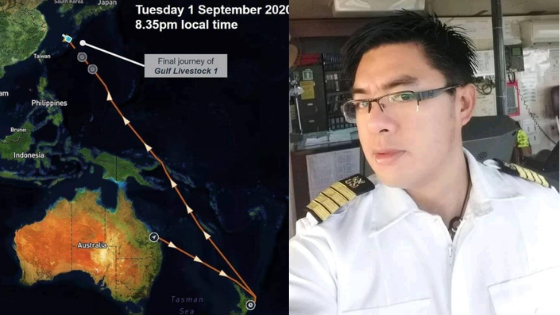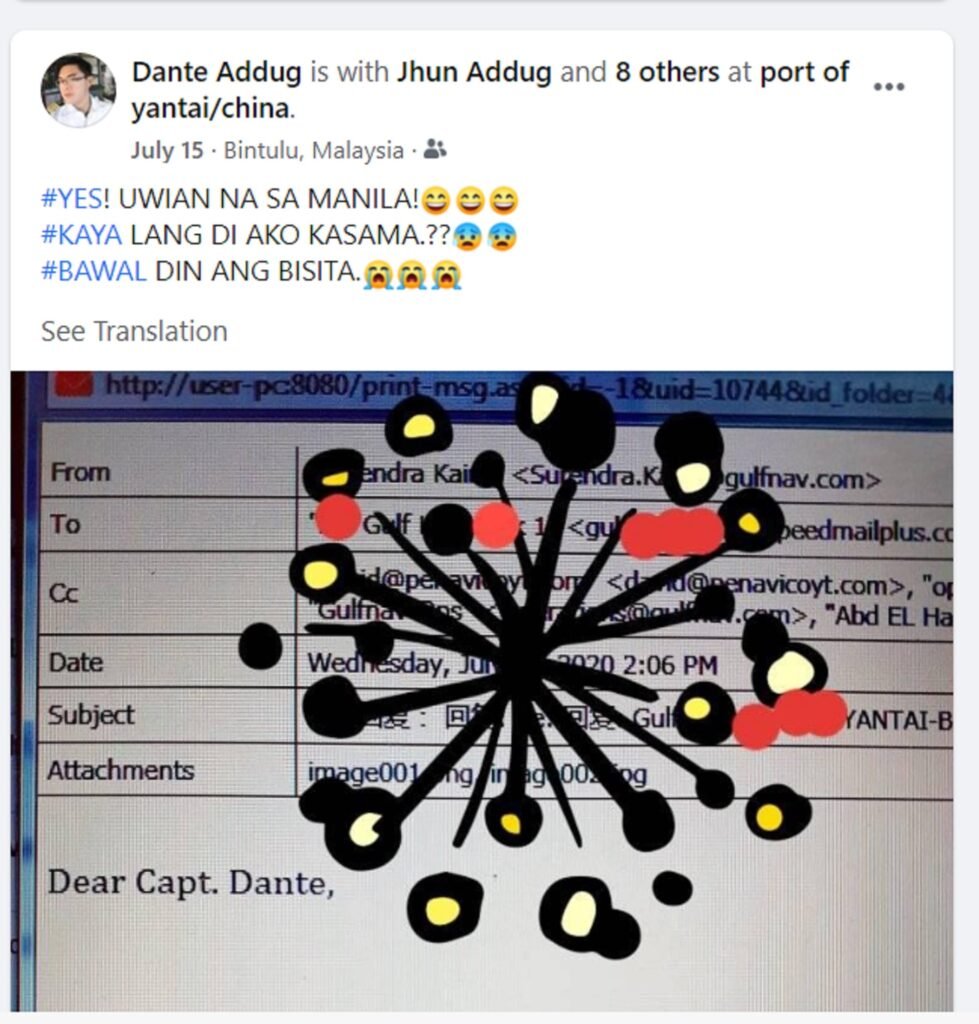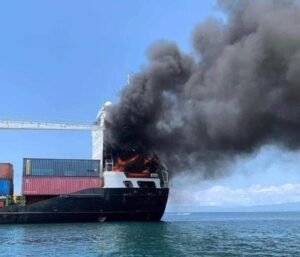In Sept 2014, a promising young man in his late 20’s, notched his first day at the Livestock shipping industry. On August 27, just four days shy of the beginning of this same month on this year, a nearly stationary tropical depression was seen developing over the western Pacific, east of the Philippines. Early the following day, the warm seawater temperatures and low vertical wind shears began manifesting its transformative power and it has turned into a tropical storm as it barreled on a Northwesterly track. With vertical wind shears low, unable to tear up the machinery of this powerful natural phenomenon, the warm core was able to remain above the surface circulation center. And as the area was conducive to intensification owing to such environmental factors of its birthplace, the tropical depression has turned into a severe tropical storm two days after it began. It was given a name: Maysak.
On the evening of August 29, an eye awakened and ominously peered towards the darkening heavens. It has also shifted its course northward in response to a nearby subtropical ridge of high pressure. This swirling force of nature, a heat engine fueled by the temperature gradient between water and air — has become a Typhoon.
And yet, the following day after that, August 30, this rumbling behemoth whose girth now encompasses hundreds of kilometers, showed signs of rapid intensification. The water temperature of the ocean’s water was high down to a depth where no cool water was able to well up the surface and cool its anger. An anticyclone above the eyewall channeled the air away from the cyclone efficiently. An approaching trough over eastern China and Western Japan fueled its acceleration as it thundered towards the north, the energetic ocean waters it was traversing whipped into a frenzy of high, cavernous waves. By then, the eye has become symmetric and initially spanned 55 kilometers in diameter till eventually, like a monster’s eye, narrowed to nineteen. From space, it is a beautiful sight, but on the earth’s surface, there is no questioning the danger it posed.
It sustained this intensity till at its strongest, packed winds of 175 kilometers in ten minutes period with a gust speed that would chill even the most bravehearted’s blood – 250 kilometers per hour. On the day of its peak, the system registered as a category 4 storm. And it was also on its fiercest that the storm and the man I mentioned when I began, now with the command of his ship, officers, and crew, would unfortunately meet.
And the day that followed that would be the day of reckoning.
In the early morning of September 2, a distress signal pierced the airwaves, emanating 185 kilometers west of Amami Oshima island, Japan. It was a signal of distress. And it came from Gulf Livestock 1.
And thus, therefore, immediately after that, even as Maysak continued its short but powerful life, another maelstrom ensued afterward — this time within the ether confines of the internet’s news sites and social media.
I followed closely the news and postings as the events unfolded. I posted a call for prayers. And lately, I curiously delved on what people have got to say. I saw from the words of many how the full brunt of the responsibility was laid on the shoulders of the ship’s captain, my junior Dante Addug of class 2007. Everyone had an opinion and it was their right to do so. To reflexive villainize is a part of human nature, especially in the face of such tragedies wherein loss of lives is involved and there is no clear answer.
So tonight, I’m gonna try to lay this out further with words that are designed to resonate.
I have always considered myself a student of human nature and I have begun fastidiously with the most interesting subjects, myself, and my interactions and experiences. In the year 2008, I was on board a ship less than 2000 gross tonnage and we have just finished offloading our cargo in New Zealand. The people from shore have already warned our Captain that there was a depression that recently formed just outside Townsville in Queensland, Australia. It has been forecasted to deepen at bomb rate and in just a day after our planned departure, would square itself at the top of New Zealand’s North island. It is forecasted to be the deepest in recent years and would still carry its warm core upon reaching Kiwi waters. On the 24th of July, our departure day, weather analysts monitoring its progress called the storm “nasty” and possessing a “significant risk” to life and property. They also called it “serious” and expected it to cause damages. Even our pilot made a last-ditch appeal for the Captain to cancel our departure. Our Captain proceeded anyhow.
Less than 24 hours after leaving Wellington and upon rounding Cape Reinga, New Zealand’s northernmost point, the storm caught up on us.
What followed were nearly three days of a small ship terrifyingly swaying from side to side as well as lurching up and down. Here and there, ship equipment and items were strewn and had our radio and navigation equipment not been secured and tied well, would have been pulled from their fastings. The same could be said on all our supplies. But at its worst, there came a point, I believe, that just like me, nearly everyone had a seed of doubt planted in their minds that this could turn out terribly to the south if something goes wrong. Though sleepless, disheveled, and listless, we breathed a collective sigh of relief when the storm finally dissipated, utterly grateful for being able to ride it out.
I shared this anecdote in part to add to the contexts I have not seen written about whilst browsing the comment sections of the postings about the fate of Gulf Livestock 1. Later on, as this piece closes, I hope I could shed enlightenment as to why.
Again, let me state that I do not know what exactly transpired on board the ill-fated ship. Nor am I here to exhort you to change your minds on the judgments you have already made despite the lack of details on the true narrative behind a sad story you have only read about. All I can do is try to state perspectives that I know need to have its share of telling.
Dante started his education at the Philippine Merchant Marine Academy and graduated in the year 2007. From an article he wrote for Vroon’s Company Magazine (News Express) June 2018 issue, he began his career in the bulk and oil ships before setting his sights to the Livestock shipping industry. He joined Vroon after admiring one of its vessels and decided to apply to the company upon returning home. He was taken in on Sept 2014 and as is written when I began, notched his first day at the Livestock shipping industry. A year after, October of 2015, he was promoted to Chief Officer rank. Two years after, on the very same month, at only 31 years of age, Dante, by his own words, “found himself sitting on the Captain’s chair.”
And now, I begin my discernment.
First contention: he was too young to be promoted as a Captain.
On this matter, let me say that a company’s judgment call is nothing but strenuous and exhaustive. Shipowners who know that the true value of their ships and cargoes runs at millions of dollars need someone at a TEN. Someone who does not only know the ship handling theories, the workings of how a ship runs, or the relevant literature from international conventions down to Company manual and directives, but whose work ethics is also extolled by a team of believers, foremost of which are the crew and officers he has previously sailed with. Promoting someone to command a ship is way more stringent than anyone unaware has thought of. There is no politics nor favoritism and is WHOLLY based on competence. You couldn’t just bump anyone up the chair in the orchestra. You need someone who can compose a symphony. Surely he has done all the hard yards in achieving what he did. Thus, placing these facts before those who merely assume and seek to put sweeping malice to not only Dante but all other Captains promoted early in their shipping careers, let me now address him by his proper title: CAPTAIN DANTE ADDUG.
Another off-handed remark I have read is that Captain Addug was not maneuvering away from the storm. Since time immemorial, when men went out to sea, the relationship between masters and storms has always been taut as a garrote. A master knows that it’s not gonna be a question of who blinks first and will not dig his heels in the face of such danger. Storm Maneouvering 101 is a primary knowledge for them, passed down from generation to generation. Besides, his decade of experience as a ship’s junior and chief officer and nearly three as ship’s master ensures this was not his first rodeo. And there is no other greater argument against this assumption than the fact that they have lost their ENGINE’S POWER. We are not there and we couldn’t walk through his mental processes as to what he intended to do but was unable to because of what happened. And solemnly, out of respect, I end with that, knowing that all other investigations’ closures’ would only yield conjectures, for the ship itself, the ultimate body of evidence is now gone. With that, I call upon those who have read this far to continue praying and having faith that VERY SOON NOW, Captain Addug himself, and the rest of his crew would finally be rescued.
All the rest of what other people think and wrote I will no longer touch upon.
But I shall continue. Disclaimer: YOU WILL BE IN FOR A SURPRISE.
What I know to be true is that mental health studies and evaluations all around the world have come up with a collective conclusion that in these uncertain times, the rate of mental stress and fatigue amongst all people in all demographics and fields has sharply risen. Two studies that were done even BEFORE the pandemic, that of the Seafarers International Research Centre of the School of Social Sciences (Cardiff University) and the ITF Seafarers Trust and Yale University study, concluded as well the stark difference of mental health troubles suffered by seafarers as compared with those in the general population who are land-based. According to those studies, there is evidence that in some roles seafarers may be particularly prone to emotional exhaustion and ‘burnout’. Again, these studies were done BEFORE the pandemic.
In the paper prepared by CHIRP maritime titled “Focus on seafarer wellbeing during Covid-19 pandemic,” published April 2020, there is a table that states the “Potential Impacts of COVID-19 on Seafarers.”
Here are a few:-
Length of on board service extended beyond contractual arrangements.
-Increased demand for quicker port turnaround times to keep communities supplied.
-Obligation to maintain performance standards even if suffering from distress or fatigue because of the consequences for safety.
-The unknown risk posed by visitors to ship and those coming on board such as pilots, port officials, stevedores etc.
– Increased anxiety making it difficult to concentrate and make decisions.
– Fear of their loved ones contracting the virus and being unable to protect them (as they are away).
– Increased feelings of loneliness as disconnected from communities and loved ones.
– Feeling helpless and unable to support sick / bereaved family members.
AGAIN, a few.
I am stating these not to give justifications nor offer a stark counter-narrative to events I know very little of except that which I have read. All I understand is that my brother, a graduate of the same institution I came from suffers the fate of having his name besmirched, with judgmental brickbats thrown his way. I would only have you understand that the time we are living in is extraordinary in many ways and foremost of that is the turmoil and burden it is bringing to everyone’s minds. And Captain Addug is not immune to this as he is human along with the rest of us.
We do not know whether he’s aiming for a narrow slither to avoid something that CAUGHT UP FROM BEHIND. YES, have anyone even considered that? LOOK AT THE PICTURES. Gulf Livestock 1’s journey from Napier to China would have taken 17 days. If the news is correct and they left the 14th of August, they would have already passed or were just abeam the area of the tropical depression’s genesis. And as it gained momentum in its northerly climb when it became a typhoon (remember: after recurving, the speed of travel increases to about 15 to 20 knots, and that’s not factoring in the rapid intensification which may have hastened it further), with their speed reduced by the roughening seas, they were in fact, THE ONES OVERTAKEN and just barely doing their best to ride it out. That they were NOT HEADING TOWARDS THE EYE OF THE STORM but instead, Captain Addug was most probably plotting in his mind when the exact moment would present itself that he could shift his course and direction towards the navigable semicircle! Look at the area they passed through, has anyone considered that it’s possible Captain Dante’s call was to steer away from crashing on the islets off Okinawa?
SURPRISED? I guess so. Foremost of the ones I want these facts splattered on the faces of are the ADMINS of Marino Ph who posted the news of an article by FORBES and misled it with credits to BBC! The FUCK is that? Have you ever considered to study the article FIRST and the exigencies of events as they unfolded before reposting that fucking clickbait? Look what happened when you did, like a domino effect, it was reposted by other mariner pages. My God! And Mr Nishan Degnarain, why write it slanted in a way that Gulf Livestock 1 was the only vessel heading into the typhoon? And why leave this part near the end >>> (Although the crew had reported ENGINE FAILURE, an important area of inquiry would be the decision and tools to sail into the eye of a major typhoon), <<< as if only an afterthought? Because there’s THE FUCKING RUB. “ENGINE FAILURE.” And not just an ordinary one, but something that happened while BEING CAUGHT IN THE DYNAMICS OF A FUCKING STORM. Does anyone even know how far along the engine was gone or that it may have already been sputtering for quite a while before the ship went down? No one amongst you right?
I have not sailed for a very long time but I can deduce and base from my aforementioned experience on a severe storm that CAPTAIN ADDUG did his best to make of the situation what he could, a situation that rapidly escalated and he has no control of. And once again, I repeat: THE ENGINE OF HIS SHIP FUCKING FAILED!
I look at bunkmate Addug’s wall and I see his post on July 15:
July 15 · Bintulu, Malaysia ·
#YES! UWIAN NA SA MANILA!![]()
![]()
![]()
#KAYA LANG DI AKO KASAMA.??![]()
![]()
#BAWAL DIN ANG BISITA.![]()
![]()
![]()
And as I look at the sad emoticons I realized just how strong a man he was for having kept it together for MORE THAN NINE FUCKING MONTHS and with the thought of his newborn child he was excitedly looking forward to seeing on top of that to boot. A child not even half a year of age whose father is still not found, along with the other men who, like many others, may only ever had words of affirmation as to Captain Addug’s competence and leadership.
And I woe how easily swayed clueless people are with what they hear and say without having first-hand experience of what it is they’re talking about.
I write this not only because I am George Daniel Anos, El Ejecutor, but because in some way, I understand what he has been through and knows it was never his intention to place in danger himself and his crew and even the lives of the animals in his care. And also because, as I look back on all the figurative and literal ones that came into my life, I take to heart what Haruki Murakami has written about storms:
“And once the storm is over, you won’t remember how you made it through, how you managed to survive. You won’t even be sure, whether the storm is really over. But one thing is certain. When you come out of the storm, you won’t be the same person who walked in. That’s what this storm’s all about.”
I do this to honor him against the onslaught of judgment thrown his way and believe hard he is not yet consigned as a memory for even at this very moment, he, along with everyone else, still cling tenaciously for dear life and await their rescue.
Hold on my bunkmate, hold on brothers.
Help is on its way.












